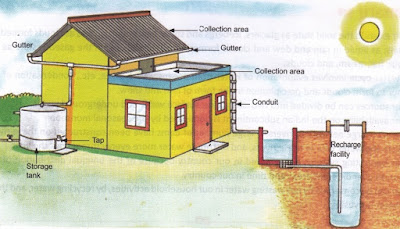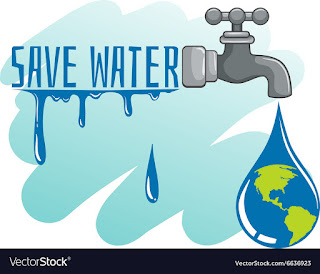 |
| Rain Rainwater Harvesting |
It is a surprising truth that during the rainy season in India, there is a flood situation in one area while there is a severe drought in other areas. Despite enough rain, people yearn for every drop of water and in many places, a situation of conflict also arises.
The main reason for this is that we did not store the precious rainwater that nature has given us and it has been washed away and become contaminated water.
On the other hand, as a result of human longing, the groundwater was exploited indiscriminately but did not return this water extracted from the earth back to the earth.
On the other hand, as a result of human longing, the groundwater was exploited indiscriminately but did not return this water extracted from the earth back to the earth.
This caused the groundwater level to fall and caused severe water scarcity. According to an estimate, around 1.4 billion people in the world do not have access to pure drinking water.
Rainwater harvesting has a long history. Archaeological excavations at Petra, Jordan, included in the World Heritage, found hoses in the seventh century BC that were used to collect rainwater.
Similarly, the rock catchment system was created in Sigiriya in Sri Lanka to collect rainwater. This system was created in 425 BC. It has also been included in the world heritage.
Evidence of collecting rainwater from 4500 years ago in the Thar region of Rajasthan state in India was found during the excavation done in Harappa.
Rainwater harvesting has been in operation in many countries like Israel, Singapore, China, Australia for a long time. Now the time has come when public awareness should be encouraged to implement this technique in India also.
This is a very easy technique. Under this, the rainwater is stored through drains/pipelines so that it can be used again, by preventing the wastewater from flowing.
Table of Contents
What is rainwater harvesting?
The process of collecting this water after rain for productive purposes is called rainwater harvesting. In other words, the work of collecting rainwater falling on your roof in a normal way and purifying it is called rainwater harvesting.
Requirement
Today, the lack of good quality water has become a cause for concern. Although pure and good quality rainwater drains soon. But if it is collected, control over watercourse can be found. Looking at the present water crisis, this is the only option left by which we can get the solution of the water crisis.
Suitable Place
Generally, rainwater harvesting can be done anywhere, but for this, the places where the flow of water is fast and the rainwater flows quickly. Thus, rainwater harvesting is best suited for the following places:
- Low groundwater sites,
- Polluted groundwater sites,
- Mountainous/uneven water sites, 4. Drought or
- flood affected sites,
- Polluted water sites. ,
- Places with less population density,
- Places with more mineral and saltwater, and
- Places with expensive water and electricity.
Use
Generally, rainwater is pure water and it can be used for all purposes, however, it is best suited for the following tasks:
- Cleaning utensils,
- Bathing and washing clothes,
- Defecation etc.
- For irrigation,
- Cattle drinking, bathing, etc.
- Industrial work, after checking the quality of rainwater, if it is found suitable, then it can be used for making drinking water and food. There may also be used.
Advantages
- Reduced dependence on groundwater/government water supply,
- Agricultural work is also possible where there are no water sources,
- Self-sufficiency in the water sector,
- Achievement of high quality and chemical-free water,
- The minimum cost of water supply,
- Soil erosion is minimized by controlling flood velocity,
- Availability of adequate amount of water to all,
- The falling groundwater level can be raised,
- It acts as the main source of water,
- This water Every appearance And is free from deadly salts etc.
- In densely populated areas, rainwater flows from the roofs into the drains and creates dirt, while storing it can relieve the problem.
- There is no evaporation of the water stored inside the soil, so there is little chance of water running out.
- The intensity of salts in the water stored inside the ground is low.
- There is no dependence on other sources.
Some Precautions Precaution
- With the help of rainwater harvesting, the accumulated water should be filtered thoroughly before use so that the impurities present in it are separated from the water.
- Rainwater should be stored in such utensils or containers which do not create poisonous elements when exposed to sunlight.
- It is very important to boil the drinking water stored by rainwater harvesting properly so that the toxic elements and bacteria present in it are cleared.
Methods Of Rain Rainwater Harvesting
1. Surface Water Collection Systems
Surface water is the water that after rain falls on the ground and starts flowing into the lower parts of the earth. The method of preventing surface water before it goes into dirty unhealthy drains is called surface water collection. Through large drainage pipes, the rainwater is stored in wells, rivers, zak ponds, which subsequently removes water shortages.
2. Rooftop system
In this method, you can store rainwater falling on the roof. In such situations, open tanks are used at high altitudes in which rainwater is stored and transported to houses through drains. This water is clean, which can be fully utilized after adding a little bleaching powder. This method is very suitable for small houses with a roof of one thousand square feet.
In a rainy season, about one lakh liters of water can be discharged from the small roof inside the ground. For this, first of all, a pit has to be made 3 to 5 feet wide and 5 to 10 feet deep in the ground. Water from the roof is discharged into the pit through a pipe.
After the excavation, this pit is piled at the bottom with thick stones (pebbles), in the middle, medium-size stones (rods) and at the top fine sand or gravel. This method is the easiest method of filtering water. This system acts as a filter.
3. Dam
by the construction of large dams, we harvest rainwater very large scale which is also used for industrial use, domestic use in the summer months or through lack of water through agriculture, power generation and drains. The dams have proved to be very useful in terms of water conservation, so many dams have been built in India and new dams are being built as well.
4. Underground Tanks
This is also an excellent way through which we can conserve water inside the land. In this process, rainwater is sent to an underground pit which increases the amount of groundwater.
Ordinarily, the water flowing over the land itself becomes steam from the heat of the sun and we are not able to use it, but in this way, we can save more and more water inside the soil. This method has proved very helpful because the water inside the soil does not dry easily and we can use it through the pump for a long time.
5. Water Collection Reservoirs
It is a simple process in which rainwater is stored in ponds and small water sources. The water stored in this method is mostly used for agricultural purposes because it is contaminated.
How To Save Water
- Use only as much water as you need.
- Close the tap tightly after using water.
- Do not keep the tap running while brushing, washing utensils and clothes. Open the tap as needed.
- In the event of leakage of the faucet, repair and repair the mechanic immediately.
- Use a washing machine that saves water.
- Instead of throwing water in the bucket or bottle, put it in the plants instead of throwing it.
- After washing fruits or vegetables, put that water in the beds and plants.
Also, read
THERMOCHROMIC CEMENT
WHAT IS THERMAL INSULATION- TYPES OF MATERIAL


